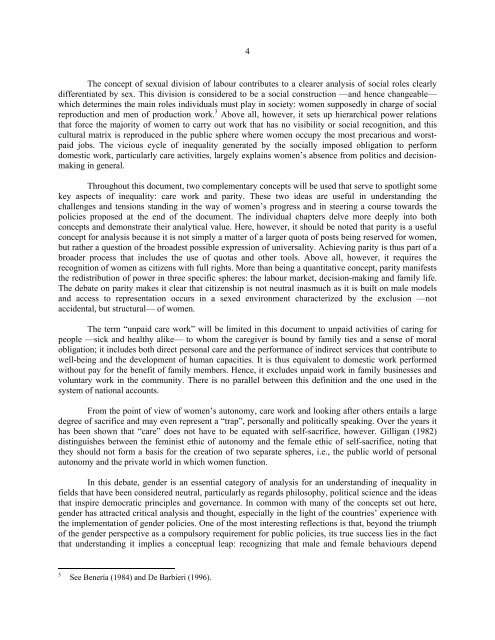Women in Latin America and the Caribbean - Cepal
Women in Latin America and the Caribbean - Cepal
Women in Latin America and the Caribbean - Cepal
You also want an ePaper? Increase the reach of your titles
YUMPU automatically turns print PDFs into web optimized ePapers that Google loves.
4<br />
The concept of sexual division of labour contributes to a clearer analysis of social roles clearly<br />
differentiated by sex. This division is considered to be a social construction —<strong>and</strong> hence changeable—<br />
which determ<strong>in</strong>es <strong>the</strong> ma<strong>in</strong> roles <strong>in</strong>dividuals must play <strong>in</strong> society: women supposedly <strong>in</strong> charge of social<br />
reproduction <strong>and</strong> men of production work. 3 Above all, however, it sets up hierarchical power relations<br />
that force <strong>the</strong> majority of women to carry out work that has no visibility or social recognition, <strong>and</strong> this<br />
cultural matrix is reproduced <strong>in</strong> <strong>the</strong> public sphere where women occupy <strong>the</strong> most precarious <strong>and</strong> worstpaid<br />
jobs. The vicious cycle of <strong>in</strong>equality generated by <strong>the</strong> socially imposed obligation to perform<br />
domestic work, particularly care activities, largely expla<strong>in</strong>s women’s absence from politics <strong>and</strong> decisionmak<strong>in</strong>g<br />
<strong>in</strong> general.<br />
Throughout this document, two complementary concepts will be used that serve to spotlight some<br />
key aspects of <strong>in</strong>equality: care work <strong>and</strong> parity. These two ideas are useful <strong>in</strong> underst<strong>and</strong><strong>in</strong>g <strong>the</strong><br />
challenges <strong>and</strong> tensions st<strong>and</strong><strong>in</strong>g <strong>in</strong> <strong>the</strong> way of women’s progress <strong>and</strong> <strong>in</strong> steer<strong>in</strong>g a course towards <strong>the</strong><br />
policies proposed at <strong>the</strong> end of <strong>the</strong> document. The <strong>in</strong>dividual chapters delve more deeply <strong>in</strong>to both<br />
concepts <strong>and</strong> demonstrate <strong>the</strong>ir analytical value. Here, however, it should be noted that parity is a useful<br />
concept for analysis because it is not simply a matter of a larger quota of posts be<strong>in</strong>g reserved for women,<br />
but ra<strong>the</strong>r a question of <strong>the</strong> broadest possible expression of universality. Achiev<strong>in</strong>g parity is thus part of a<br />
broader process that <strong>in</strong>cludes <strong>the</strong> use of quotas <strong>and</strong> o<strong>the</strong>r tools. Above all, however, it requires <strong>the</strong><br />
recognition of women as citizens with full rights. More than be<strong>in</strong>g a quantitative concept, parity manifests<br />
<strong>the</strong> redistribution of power <strong>in</strong> three specific spheres: <strong>the</strong> labour market, decision-mak<strong>in</strong>g <strong>and</strong> family life.<br />
The debate on parity makes it clear that citizenship is not neutral <strong>in</strong>asmuch as it is built on male models<br />
<strong>and</strong> access to representation occurs <strong>in</strong> a sexed environment characterized by <strong>the</strong> exclusion —not<br />
accidental, but structural— of women.<br />
The term “unpaid care work” will be limited <strong>in</strong> this document to unpaid activities of car<strong>in</strong>g for<br />
people —sick <strong>and</strong> healthy alike— to whom <strong>the</strong> caregiver is bound by family ties <strong>and</strong> a sense of moral<br />
obligation; it <strong>in</strong>cludes both direct personal care <strong>and</strong> <strong>the</strong> performance of <strong>in</strong>direct services that contribute to<br />
well-be<strong>in</strong>g <strong>and</strong> <strong>the</strong> development of human capacities. It is thus equivalent to domestic work performed<br />
without pay for <strong>the</strong> benefit of family members. Hence, it excludes unpaid work <strong>in</strong> family bus<strong>in</strong>esses <strong>and</strong><br />
voluntary work <strong>in</strong> <strong>the</strong> community. There is no parallel between this def<strong>in</strong>ition <strong>and</strong> <strong>the</strong> one used <strong>in</strong> <strong>the</strong><br />
system of national accounts.<br />
From <strong>the</strong> po<strong>in</strong>t of view of women’s autonomy, care work <strong>and</strong> look<strong>in</strong>g after o<strong>the</strong>rs entails a large<br />
degree of sacrifice <strong>and</strong> may even represent a “trap”, personally <strong>and</strong> politically speak<strong>in</strong>g. Over <strong>the</strong> years it<br />
has been shown that “care” does not have to be equated with self-sacrifice, however. Gilligan (1982)<br />
dist<strong>in</strong>guishes between <strong>the</strong> fem<strong>in</strong>ist ethic of autonomy <strong>and</strong> <strong>the</strong> female ethic of self-sacrifice, not<strong>in</strong>g that<br />
<strong>the</strong>y should not form a basis for <strong>the</strong> creation of two separate spheres, i.e., <strong>the</strong> public world of personal<br />
autonomy <strong>and</strong> <strong>the</strong> private world <strong>in</strong> which women function.<br />
In this debate, gender is an essential category of analysis for an underst<strong>and</strong><strong>in</strong>g of <strong>in</strong>equality <strong>in</strong><br />
fields that have been considered neutral, particularly as regards philosophy, political science <strong>and</strong> <strong>the</strong> ideas<br />
that <strong>in</strong>spire democratic pr<strong>in</strong>ciples <strong>and</strong> governance. In common with many of <strong>the</strong> concepts set out here,<br />
gender has attracted critical analysis <strong>and</strong> thought, especially <strong>in</strong> <strong>the</strong> light of <strong>the</strong> countries’ experience with<br />
<strong>the</strong> implementation of gender policies. One of <strong>the</strong> most <strong>in</strong>terest<strong>in</strong>g reflections is that, beyond <strong>the</strong> triumph<br />
of <strong>the</strong> gender perspective as a compulsory requirement for public policies, its true success lies <strong>in</strong> <strong>the</strong> fact<br />
that underst<strong>and</strong><strong>in</strong>g it implies a conceptual leap: recogniz<strong>in</strong>g that male <strong>and</strong> female behaviours depend<br />
3<br />
See Benería (1984) <strong>and</strong> De Barbieri (1996).











